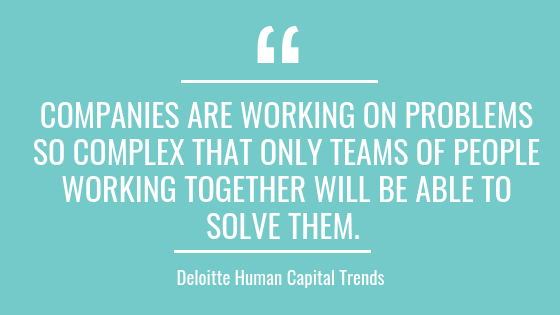

Team diagnostics, or in other words, a team health check, is mainly a survey methodology to find out where your team stands. It’s a first step towards understanding what’s going on with your team and what to tackle in order to make it more effective. You can do this at any point in time, either with a new team you just brought together or with a previously established team, that’s been there for a longer time. Think of it as going to the doctor for a routine check: it’s important to get yourself checked as an individual, but as a family too. And a team is a family. The aim is to find out whether you’re “healthy” or have a “stomach bug” or even have a “disease” that can potentially be cured. Also, discovering the “healthy” areas is just as important. Focusing on your strengths, and leveraging them to be stronger and better can take your team performance even further!
Why team diagnostic instead of individual diagnostic?
need for an effective team and effective teamwork as well. A group’s intellectual power increases exponentially with each person that joins. Each of them brings a unique skill set and talent to the table. Enterprises constantly work on employee effectiveness and retention as the magic formula to create high-performing organizations. However, benefiting a single person’s satisfaction is contrary to the image (and goal), of a system where each person’s tasks and results depend on one another and are interconnected- in other words, a Team.

Before talking about enabling a team to be effective we need to ensure the team has solid communication elements built in. Performing a team diagnostic helps you understand these elements fundamentally and helps capture the state that the team is in. It’s indeed a crucial way to develop company culture, more specificall, Feedback Culture, more specificall, Feedback Culture, the first step to setting your team up for success.
While there are different methodologies, at WeWent we choose to focus on 6 aspects to understand a team’s existing – or not – dynamics.
1. Team purpose
Every team needs a clear purpose. They need to be clear on their tasks and expectations. As Simon Sinek puts it: They need their “why”. The number one rule to building an effective team is that all the members are aligned on a common goal. Everybody on the team has to know their role in achieving that goal. Ensuring the team fully embraces the purpose (or that one is collectively defined), is key in order to get the team satisfaction they deserve. Check out Simon Sinek’s world famous “start with why” video to capture the essence of why. The “WHY” is crucial to both teams and companies.
2. Team relationships
We are social creatures and the way others perceive us, matters. When a team lacks trust, open-mindedness and psychological safety there’s no place for creativity or innovation. One person’s toxic behaviour (negativity, shaming, blaming etc.) is enough to influence the whole team, causing all the others to lose their positivity competencies (trust, optimism, respect, constructive interaction etc.). That’s why measuring the state of team relationships is another building block to sustain an effective team.
3. Team skills
Two years ago Google set out to understand what makes for an effective team. The researchers thought team composition would be most important. But it turned out that how a team interacts is far more important than who is on the team. Hence developing and leveraging the skills of the team should be one of the main building blocks of creating the right environment. This means understanding each team member and whether they feel supported on the areas that they need to grow. It’s part of creating a safe environment.
It’s about developing and leveraging the soft and more technical or functional skills of the team to help it excel in the present and future.
4. Team structure & clarity
Communication within the team runs better when there’s a set of rules previously agreed upon. We call it Ways Of Working (WOW). These are methods and processes to help create harmony and routine. The idea is that it avoids misunderstandings and mistakes. However, 50% of the teams are working on an “invisible” set of rules. Learning how clear the teams are on these terms can be vital for the company. This is believed to be a common problem especially after the reorganization of a company. The new group of teams are expected to adopt top-down approaches or create similar methodologies immediately.
5. Team reviews
In a team where feedback culture is embedded, it’s easier to monitor issues and successes. It’s about taking time to acknowledge the failures, wins or efforts in a timely manner as a team. Explicitly appreciating efforts, expressing gratitude and celebrating success, boosts employee morale. Reviewing what can be done better leads to learning from mistakes while recognizing small wins.
How to implement recognition and development for your team will remain a mystery until you understand the individual needs. And that’s where a team diagnostic performance can help. The diagnostic tool will help the team provide a diagnostic decision to work on some areas they need to focus.
6. Meaning & Impact
People want to feel that their work makes a difference. They are ok with crunching an excel sheet day in day out if they know it makes an impact in one way. White-collar jobs are not anymore about taking bread home but rather finding a passion behind. This trend of fulfilment at work is rising as the number of millennials increase in the workforce. By 2020 nearly half of the workforce will be comprised by millennials and it is a fact that millennials work for a purpose. They are also loyal to the job rather than the employer. Hence the sense of fulfilment should be at the core of the team. Team diagnostics can help you uncover whether your members find meaning in their daily job.

What comes after the team diagnostic results?
Each point we covered has a direct link to the ROI of the company. There are many factors that play a role in a team’s performance for instance team size, past experiences, wellbeing, work-life balance, company culture etc. And they are influenced by one or even a combination of those factors. If your team is having a hard time, doing a team diagnostics will clarify the reason and help you find a solution. Maybe you need to clarify team roles. Or change the way goal setting is done, change the behavioural approach, out a new reward system, set up a group incentive system, undertake an inspiring mission etc.
The best would be to discuss the results of your team diagnostics with an expert or team coach. Nonetheless, it’s the first step to draw a picture of where your team is at. Creating a plan to move towards an engaged and highly-effective team would be the second. Show your team that you take this journey seriously and that you’re listening to them. Have you participated in a team diagnostic survey before? Share your experience in the comments. Do you have questions about how to implement a team diagnostic for your team? Get in touch with us!




